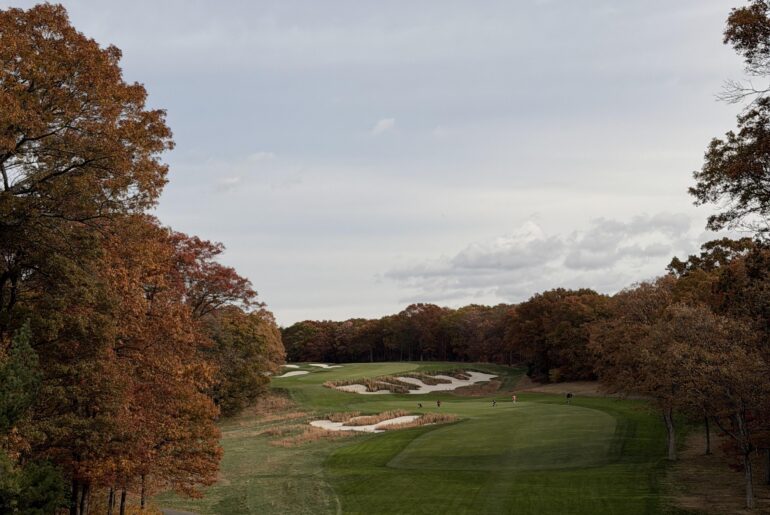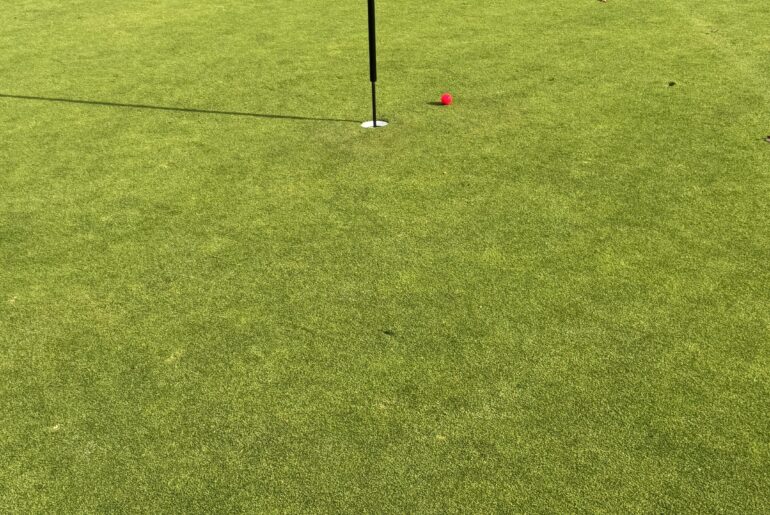
A bit of a weird one.. I was cleaning out my uncles workshop today and I would this wedge, I grabbed it to take it out back to hit some chips with it, since it was so old, had a hickory shaft ( I believe) I wanted to check it out. Only to realize the back had a few swastikas on it.. so my question is, what have I got here?
Context: my uncle is the farther thing from a Nazi so it’s not a closeted Nazi situation, my dad mentioned his father fought against the Germans in WWII and took home some other items from towns. I unfortunately cannot ask my uncle because he has late stage dementia. Is there any chance this is actually from Germany or likely just a pawn shop find at some point.
by Catamount90








33 Comments
The ole Nazi Niblick
There is a ‘two shots in a bunker’ joke around here somewhere…
This predates WWII – probably from the 1930s. So I’d assume it was intended as the original Buddhist symbol, not as a Nazi swastika.
Going from the shape of the hosel, the shaft is likely pyratone rather than hickory – metal with a faux wood covering. You can check with a magnet if you’re not sure.
That iron was made well before the morons corrupted that symbol.
Nein Iron?
The swastika probably doesn’t have anything to do with the nazi’s. From what I read it’s not a german affiliated club. Probably just using it to mean good luck.
I’m not a golf historian by any means, but as far as the swastikas there are likely two options: 1) they predate the Nazi parry and are meant to signify luck (generally speaking the original meaning of the symbol) or 2) he liberated this while over there. My guess is 1, only because it is unlikely a nazi/ German citizen would have put two together. They were pretty strict about their branding during the 3rd Reich.
Another version: [https://www.reddit.com/r/Antiques/comments/sysfih/old_golf_clubs_swastika_engraving_i_assume/](https://www.reddit.com/r/Antiques/comments/sysfih/old_golf_clubs_swastika_engraving_i_assume/)
Found some similar on eBay. Turns out these are 1920s-30’s MacGregor irons. They would routinely have clovers or flowers on them as a good luck symbol. Well, turns out the swatzika was actually around well before the Nazi party came along, and in Hindu was a symbol for good luck.
Swing Heil
Swastikas we’re around long before the Nazi and do carry other meaning even in modern times after the holocaust
No idea, but it sure is Superb…
IDK, but it looks amazing. Maybe ever more than amazing.
One could even say, superb?
Nazi swastika is other direction.
https://preview.redd.it/6liitbxup4zf1.jpeg?width=1080&format=pjpg&auto=webp&s=2d39a562f0e7e5b6fdd9511d30f58895b50de2dd
https://preview.redd.it/vq6z37nvp4zf1.png?width=1080&format=png&auto=webp&s=4cd1fe4d116b8774f5c257a051a9ff523755ecff
I have a similar club that belonged to my grandfather – he passed away when I was little, and no one remembers where he got this club, but it’s also Superb, and apparently a Mashie 5. The (I think) newer MacGregor from his set has two Clubs stamped into it, so I think the good luck charm idea is spot on.
https://preview.redd.it/iq7keubwp4zf1.jpeg?width=1080&format=pjpg&auto=webp&s=38d557ac154dc71485e76b15822ec1ed58f82a05
[Swastika vs Manji](https://www.nihongomaster.com/blog/what-is-the-buddhist-swastika-in-japan)
Yeah I think some people have pointed out but this is the Buddhist Manji symbol for good fortune, prosperity and happiness . If you look them up you’ll see the German swastika symbol is a mirror image showing that symbol reversed and also typically at a 45degree angle as well.
It’s a 1920s-30 MacGregor Superb Good Luck club. Not by any means an expert on pricing so I won’t venture a guess.
Or it’s the nein iron.
Heil Irwin’s club
When the symbol is backwards, it’s a Hindu symbol.
[deleted]
The left-facing symbol (counter-clockwise) (卍) is called sauvastika.
That’s not a Nazi Swastika.
The old niblick nazi
Oh mein gott
Not Nazi. At the time this was made, it would have meant “good luck”
Just a comment on your Uncle (from personal experience, sadly). Even when my father was consumed by dementia his oldest memories were still there. I don’t know if you still visit him, but if you did bring the club. Put it in his hands, let him feel it.
You never know, and it’s worth a shot.
“Niblick” was the old term for what’s now roughly equivalent to a modern 9-iron or wedge. Before the 1930s, golf clubs were named (Niblick, Mashie, Spoon, etc.) instead of numbered.
The engraved “Superb” suggests it was part of a model line or brand name from a small maker or store brand—common in the early- to mid-1900s.
The symbol to the right could be the maker’s mark or stamping logo, used by smaller manufacturers or blacksmiths who forged clubs in Scotland, the UK, or the U.S. during that era.
https://preview.redd.it/vqg53zhz65zf1.jpeg?width=960&format=pjpg&auto=webp&s=cc689dfb4c0d608a2878989e1bf5377cea787bbf
Something’s not Reich
perfect for shots in the bunker!